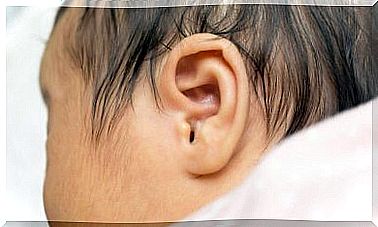The Significance Of The Neck Reflex During A Child’s Development

A child’s reflexes are known as involuntary automated responses to various stimuli. One of the most important is the neck reflex.
Knowing about it helps you understand every attitude and reaction that your child does.
One of the first aspects that pediatricians focus on at birth is the baby’s reflexes. A baby’s control over his body will depend on their ability to adapt to their environment.
These automatic responses are divided into two types: primary reflexes and secondary reflexes. The neck reflex is one of the most important primary reflexes that infants present.
What is the neck reflex?
The neck reflex, also known as the tonic neck reflex, is observed when a relaxed baby turns its face to one side while extending its arm.
The other arm remains bent at the elbow, giving it the appearance of a defensive position. Pediatricians call it fencing position.
It can be noted that when a baby performs this reflex, the arm that is in the direction where the baby is looking will be stretched out and the palm will remain open.
In the other arm, which is contracted, the hand will form a fist. This involuntary reflex can be observed on both sides of the baby’s body.

Types of neck reflexes
There are two types of neck reflexes:
- Asymmetrical reflex: This reflex consists of the child turning to the side and immediately extending the arm at the same time. It signals the correct development of the child’s hand and eye coordination.
- Symmetrical reflex: This reflex appears when the baby develops and disappears between the eighth and eleventh month. It serves as a precursor to crawling and allows the child to meet the challenge of knowing how to control the effects of gravity.
Main features of the neck reflex
Here is a summary of the general aspects of this autoresponder:
- Considered to be a broreflex ; In other words, the child is not born with it, but it develops as the child grows.
- Occurs as a result of other reflexes and that is the key to crawling and visual acuity.
- Significantly increases the baby’s muscle tone. This in turn benefits hand and eye coordination.
- Clearly when the child is placed on hands and knees when trying to balance.
- Disappears at about 6 months of age
Difficulty in properly integrating this reflex can lead to problems in the child’s fine and gross motor development, choosing the head hand and vision.
Therefore, it is important to let them experience it properly without accelerating the crawling or walking process.
The benefits of the neck reflex
One of the most important benefits of the neck reflex has to do with the preparations for crawling. Here are some other benefits:
- Promotes the movement of independent limbs, which is important for crawling.
- Improves muscle tone around the back and neck.
- Stimulates their relationship to gravity, helps them lift their body when they are on their hands and knees.
- Allows the realization of separate movements.
- Encourages the development of focus and vision, as well as their interaction.
- Favors good posture when sitting because it gives them the freedom to move their heads.
The neck reflex is undoubtedly important for infants, and it begins to disappear as they begin to walk.

Signs that the neck reflex is still active
One of the main functions of reflexes and especially the neck reflex is to enable the development of specific patterns in accordance with the child’s age.
If the reflex remains active, it will act as a symptom of immaturity in their nervous system. This will affect the development of common features.
Signs that the neck reflex is still active are:
- Poor posture while sitting. They usually support themselves in front of the chair.
- The child may be diagnosed with attention deficit hyperactivity disorder.
- General weakness in the arms and legs.
- Lack of coordination when crawling.
- Muscle hypotension. This leads to difficulties in vision, focus and precision.
- Dyslexia or difficulty learning to read and write.
In summary, the neck reflex is necessary for your child’s development.
Help them go through all stages of their development with love and care. You should also know about every aspect of their growth.









